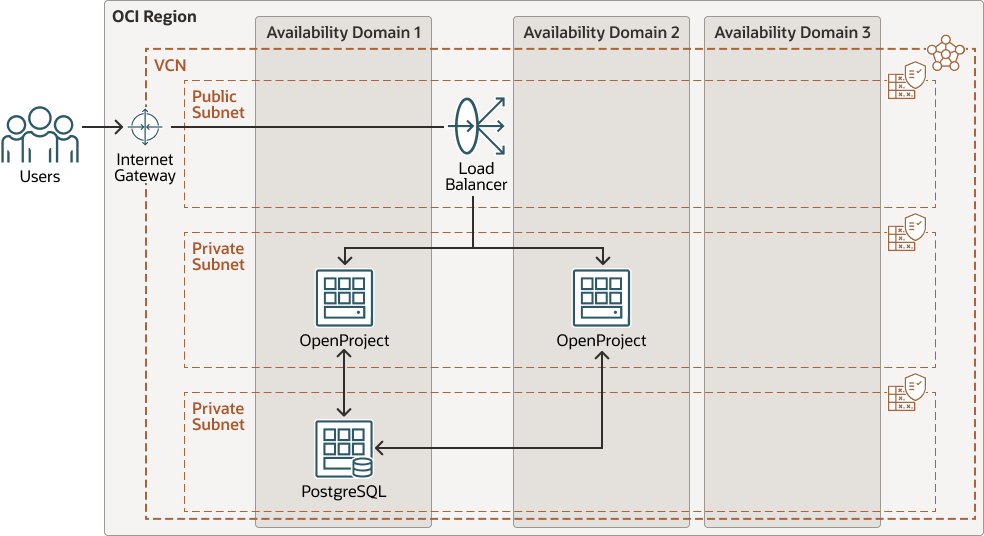Deploy OpenProject Project Management Software with PostgreSQL in Oracle Cloud Infrastructure
Deploy an open-source project management software solution to enable your teams to collaborate effectively, while leveraging the infrastructure benefits of Oracle Cloud Infrastructure (OCI).
The OpenProject Community edition is the leading open-source project management software that provides regular updates and new releases for free, released under the GNU General Public License. OpenProject is a powerful open-source project management software that offers several advantages, including:
- Collaboration: OpenProject allows teams to collaborate effectively on projects by providing a centralized platform where they can share information, track progress, and work together on tasks.
- Customization: OpenProject is highly customizable and can be tailored to suit the needs of individual teams or organizations. Users can choose from a range of plugins and add-ons to enhance the functionality of the software.
- Transparency: OpenProject offers transparency by providing real-time updates on the status of projects, including progress, deadlines, and budget. This makes it easy for project managers to stay on top of their projects and make informed decisions.
- Integration: OpenProject integrates seamlessly with other tools and services, such as GitHub, Slack, and Google Drive. This enables teams to work more efficiently and reduces the need for manual data entry.
- Security: OpenProject offers robust security features, including role-based access control and encryption. This ensures that sensitive data is protected from unauthorized access.
Architecture
You can deploy OpenProject in a single-node configuration, or as part of a multi-node, highly-available configuration. The Terraform code found in GitHub is compatible with both single-node and multi-node configurations. For a production-grade, highly-available architecture, refer to the following diagram, which illustrates a multi-node scenario.
openproject-pms-postgresql-oci-architecture.zip
The architecture has the following components:
- Region
An Oracle Cloud Infrastructure region is a localized geographic area that contains one or more data centers, called availability domains. Regions are independent of other regions, and vast distances can separate them (across countries or even continents).
- Availability domains
Availability domains are standalone, independent data centers within a region. The physical resources in each availability domain are isolated from the resources in the other availability domains, which provides fault tolerance. Availability domains don’t share infrastructure such as power or cooling, or the internal availability domain network. So, a failure at one availability domain is unlikely to affect the other availability domains in the region.
- Fault domains
A fault domain is a grouping of hardware and infrastructure within an availability domain. Each availability domain has three fault domains with independent power and hardware. When you distribute resources across multiple fault domains, your applications can tolerate physical server failure, system maintenance, and power failures inside a fault domain.
- Virtual cloud network (VCN) and subnets
A VCN is a customizable, software-defined network that you set up in an Oracle Cloud Infrastructure region. Like traditional data center networks, VCNs give you complete control over your network environment. A VCN can have multiple non-overlapping CIDR blocks that you can change after you create the VCN. You can segment a VCN into subnets, which can be scoped to a region or to an availability domain. Each subnet consists of a contiguous range of addresses that don't overlap with the other subnets in the VCN. You can change the size of a subnet after creation. A subnet can be public or private.
- Internet gateway
The internet gateway allows traffic between the public subnets in a VCN and the public internet.
- Load balancer
The Oracle Cloud Infrastructure Load Balancing service provides automated traffic distribution from a single entry point to multiple servers in the back end.
- Route table
Virtual route tables contain rules to route traffic from subnets to destinations outside a VCN, typically through gateways.
- Security list
For each subnet, you can create security rules that specify the source, destination, and type of traffic that must be allowed in and out of the subnet.
Deploy
The Terraform code to deploy OpenProject project management software is available in GitHub.
- Go to GitHub.
- Clone or download the repository to your local computer.
- Follow the instructions in the
READMEdocument.
